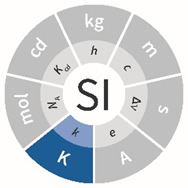Thermodynamic Temperature (the kelvin, K)
SI base unit of thermodynamic temperature
Current Definition
The kelvin, symbol K, is the SI unit of thermodynamic temperature. It is defined by taking the fixed numerical value of the Boltzmann constant k to be 1.380 649 x 10−23 when expressed in the unit J K−1, which is equal to kg m2 s−2 K−1, where the kilogram, metre and second are defined in terms of h, c and ΔvCs.

History
| Year | Definition of the kelvin |
|---|---|
| 1742 | Swedish astronomer Anders Celsius proposed the centigrade scale. The scale divided the boiling and freezing points of water into 100 degrees. The original scale set 0 as the boiling point of water and 100 as the freezing point. In 1744, the two points were swapped. In 1948, the name of the scale was changed to Celsius scale. |
| 1848 | British physicist William Thomson (Lord Kelvin) proposed the Kelvin temperature scale based on his calculation that the absolute zero was equal to -273 degree Celsius. Theoretically all substances have no thermal energy at absolute zero. 0 K is the coldest temperature possible. A temperature difference of one kelvin is equal in magnitude to a temperature difference of one degree Celsius. |
| 1954 | The triple point of water was selected as the fundamental fixed point and assigned to it 273.16 K. The definition of the unit of thermodynamic temperature, unit "degree kelvin" was defined in terms of the interval between the absolute zero and the triple point of water. |
| 1968 | The kelvin, symbol K, instead of "degree kelvin" was adopted as the unit of thermodynamic temperature. Both thermodynamic and practical units were defined to be identical and equal to 1/273.16 of the thermodynamic temperature of the triple point of water. |
| 2005 | The CIPM decides that the kelvin refer to water of isotopic composition of the Vienna Standard Mean Ocean Water (VSMOW). |
| 2019 | The kelvin was defined by fixing the numerical value of the Boltzmann constant k to 1.380 649 x 10-23 |
Reference
- The International System of Units (SI) – Base Unit
- Kelvin: History
- The ninth SI Brochure.